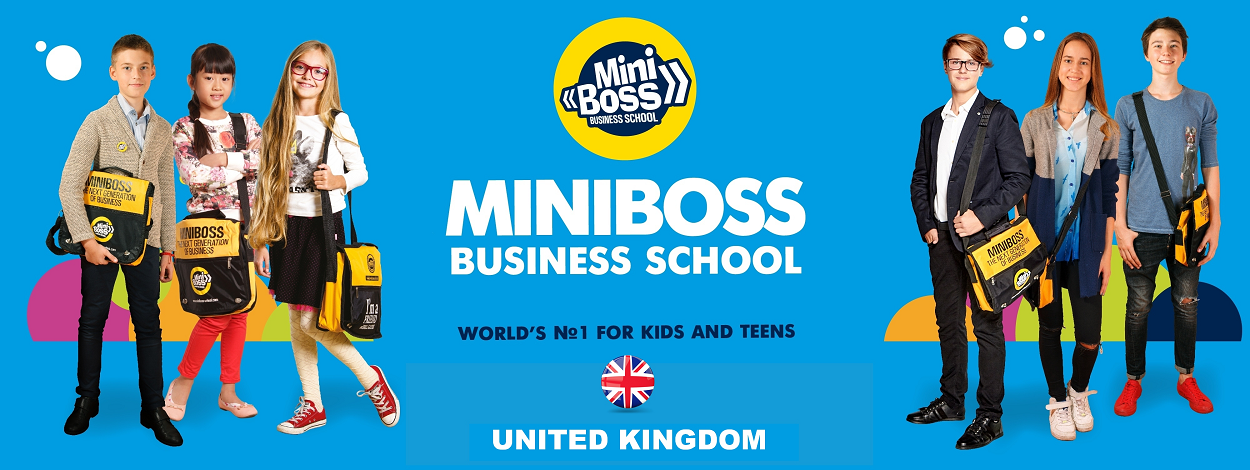Uniqueness is rare, and coming up with a continuous stream of products with unique features is, in practice, extremely difficult.
A unique selling proposition is a description of the qualities that are unique to a particular product or service and that differentiate it in a way which will make customers purchase it rather than its rivals.
What is a Unique Selling Proposition? With 15 USP Examples (2023)
Every business does something unique that sets them apart from the competition. You might offer a higher-quality product, provide exceptional customer service, or fulfill orders faster than anyone else. But it doesn’t give you an advantage if no one knows about it!
That’s where your USP comes in. As a business owner, you need to sum up your company’s unique strengths in a simple sentence that everyone can understand.
In this post, we’ll go over what exactly a unique selling proposition is, and we’ll examine 15 strong USP examples and tips that will inspire you to create your own.
A unique selling proposition is a unique aspect of a company’s products and/or services that sets them apart from what competitors offer.
It’s often summed up in one statement (ten words or less) that’s concise, catchy, and memorable.
To understand the difference from slogan, let’s look at the company slogan: “Taking your business to the next level.” It sounds great, but it’s not a USP. It doesn’t help prospective customers understand exactly why they should choose you over other brands. Customers will have lingering questions like, “How are they going to take my business to the next level?” or “Is this company going to help me finance my business upgrades?” This confusion can cause you to lose business.
Compare that to Sirius XM’s compelling USP: “180+ channels, commercial-free music.”
Those few words explain exactly what’s unique about their satellite radio in comparison to regular radio. Namely, you’ll have more choices, and you won’t need to listen to ads.
To sum up, the best answer to the question “What is a USP in marketing?” is that it’s a sentence that expresses the qualities that differentiate your company from other businesses.
Now it’s time for our deep dive into some unique selling propositions.
15 strong unique selling proposition examples and why they work
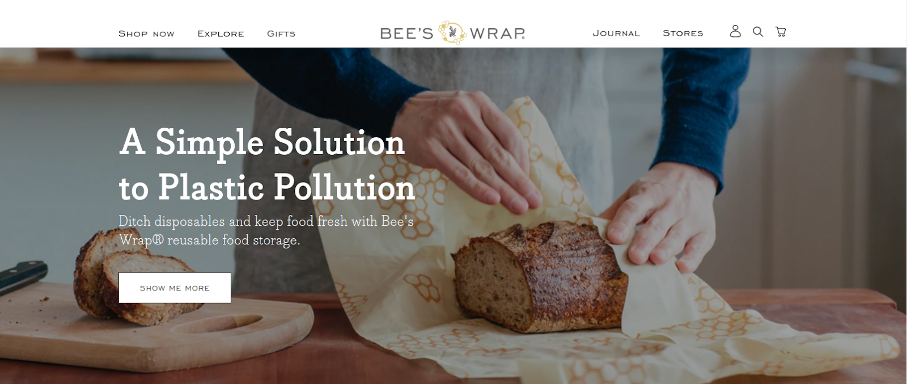
Let’s take a look at some effective unique selling proposition examples.
1. Bee’s Wrap: “A Simple Solution to Plastic Pollution”
Bee’s Wrap sells reusable food wraps that are made from cotton, beeswax, and tree resin to replace plastic wraps.
The name of the company, “Bee’s Wrap,” already denotes natural, healthy products, and their USP reinforces the environmental benefits of using their wrap.
Thus, they’re able to position themselves as solving a problem that no one likes—plastic pollution—differentiating themselves from their competition.
 2. FedEx: “When it absolutely, positively has to be there overnight”
2. FedEx: “When it absolutely, positively has to be there overnight”
FedEx used this strong unique selling proposition between 1978 and 1983. And it’s been taught in business schools ever since.
The whole point of FedEx is getting packages from one place to another, quickly and reliably. They state this clearly in their USP.
The repetition “…absolutely, positively…” subtly draws attention to the fact that FedEx knows the importance of overnight shipping for their customers. And they promise to deliver.

5. American Musical Supply: “Rock now! Pay later.”
This is one of the best examples of how a USP can reflect a company’s brand and culture.
American Musical Supply is an online retailer of musical equipment. And they know that their customers want to buy expensive items without breaking the bank (especially people starting a new musical hobby, beginners in school, or shoppers on a tight budget).
When their customers realize they can use a payment plan, they start to shop more freely without limiting themselves to a certain price point.
This USP speaks to what matters most to American Musical Supply’s customers—getting the right gear, right now.
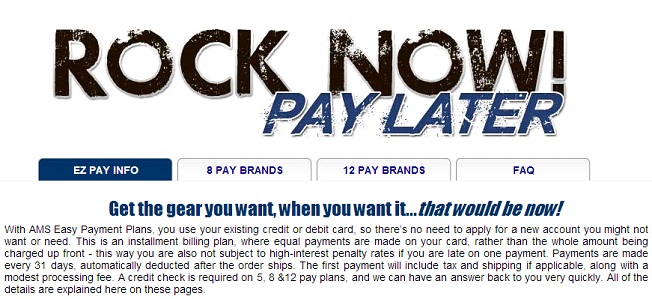
6. WooCommerce: “The most customizable eCommerce platform for building your online business”
The company’s USP works for two reasons. First of all, the superlative (“the most customizable”) instantly raises it above the competition.
But perhaps more importantly, it also speaks to an aspect of website building that potential customers worry about: whether their site will look too formulaic or “cookie-cutter.”
WooCommerce successfully builds their USP around an aspect of their service that people care about.

7. Domino’s Pizza: “Fresh hot pizza, delivered in 30 minutes or less or it’s FREE!”
Domino’s Pizza has a memorable USPs that consumers associate with the brand: “Fresh hot pizza, delivered in 30 minutes or less or it’s FREE!” or "50% Off Pizza when you spend 30 or more online".
Their specific promise allows customers to form concrete expectations about their service. It’s also not something you’re used to hearing from delivery services, which makes it stand out.
Their specific promise, which they frame as a guarantee, allows customers to form concrete expectations about their service. Finally, the rhyme in their USP (“guarantee” and “free”) helps a customer remember it.
.jpg)
9. Pureformulas: “Orders placed before 6 pm EST ship the same day”
Pureformulas’ unique selling proposition is tailor-made for people who care about their vitamins and supplements. They know that their customers don’t want to miss taking them, even for a single day.
That’s why their USP, with its promise of same-day shipping, perfectly meets their customers’ needs and differentiates them from their competitors.

10. Best Buy: “Find a lower price and we’ll match it”
Best Buy’s famous USP helped define them as a brand. Since consumers usually can’t get a lower price than the sticker price—especially in electronics stores—Best Buy’s USP promises something unique: an unfettered ability to price match.
Interestingly, the subtext of the USP adds another layer: it’s almost like a challenge. Best Buy implies that you won’t be able to find lower prices, because theirs are the best.
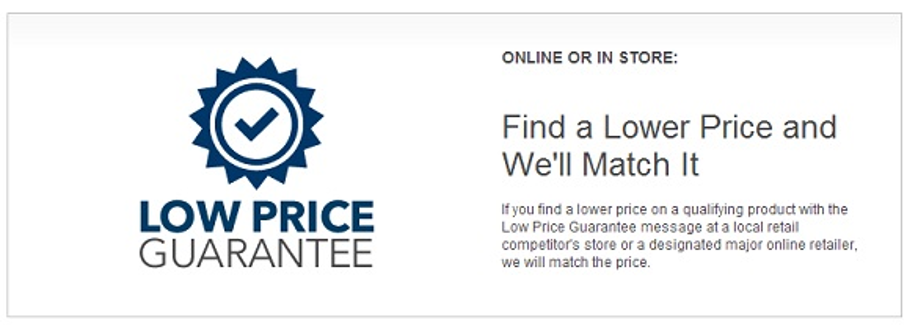
11. Warby Parker: “Try 5 frames at home for free”
Warby Parker’s clever USP solves the biggest problem with buying glasses in an online store: it’s very hard to imagine what you’d look like in a pair of glasses without actually trying them on!
That’s why their offer to try on five different frames for free is so effective. They’re eliminating the risk involved with choosing a pair of frames online—if the customer isn’t thrilled with the first pair, it’s no big deal… they’ve also got four other options.
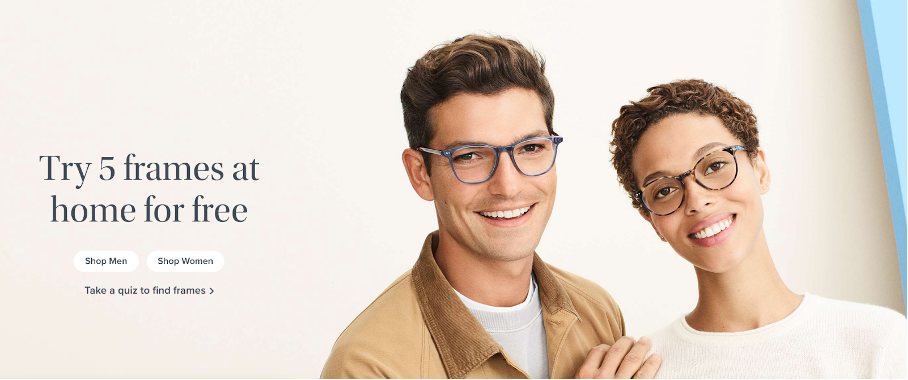
12. GEICO: “15 minutes could save you 15% or more on car insurance”
Just like FedEx, GEICO uses repetition in its USP to make it more memorable: 15 minutes and 15 percent.
This highlights the benefit new customers can expect by switching to GEICO from their current insurance providers. When you combine their USP with GEICO’s other memorable marketing efforts, you can see why they became such a successful business.
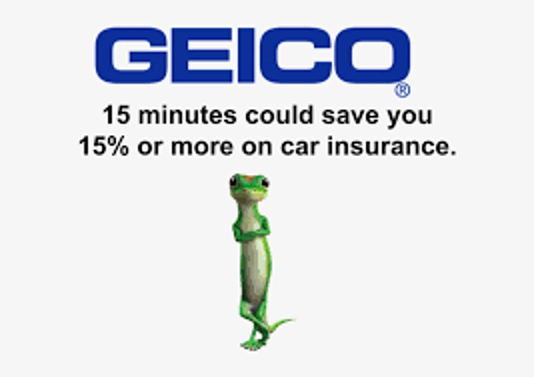
13. M&M’s: “Melt in your mouth, not in your hand”
M&M’s USP shows that being slightly offbeat in your selling proposition can yield great results.
When you read it, you might be puzzled at first, but then you remember that M&M’s have that hard shell that protects your hands. At the same time, you might imagine melted chocolate all over your hands from eating other types of candy.
At this point, you can almost taste the chocolate melting in your mouth…
By the time you’re done thinking, M&M’s USP has already worked!

14. Colgate – “Improve mouth health in two weeks”
Colgate’s USP highlights the role of toothpaste for mouth health. They know that their target audience wants an established, reputable brand when it comes to health.
And by making a specific, time-limited promise, “improve mouth health in two weeks,” Colgate projects confidence that they can actually deliver those results.
15. Patch: “Patch helps you discover the best plants for your space, delivers them to your door and helps you look after them”
Patch’s unique selling proposition is a little bit long, but it works because they need to establish what they do for their customers. The company doesn’t have the history and name recognition of FedEx or M&M’s, so they need to be more specific in their USP.
They offer three services: discovery, delivery, and post-delivery assistance.
Notice how their USP complements their slogan: Plants made easy.

We’ve gone over some great examples of unique selling propositions. Now, let’s take a look at the steps you need to follow to create your own USP.
1. List your key differences
The first step in coming up with a unique selling proposition is to find aspects of your products or services that your competitors can’t provide or don’t have.
For example, if you’re the only one in your niche market offering free shipping, that could be a part of your USP. Or your products might be more customizable than what other businesses are offering.
Once you have an exhaustive list of what differentiates your company from the rest of your industry, you’ll have tons of options for your USP. But that’s not the end of the process.
2. Research your competition
You also need to research your competition and look at their USPs.
This is another point where making a list is helpful. When you write out the USPs of other businesses in the same category, you’ll be able to see gaps in the market and use them to differentiate your brand.
For instance, if your competitors are focusing on their shipping policies, you could focus on something else.
3. Think about your customers’ needs
Now, it’s time to research your customers’ needs and expectations.
Another idea is to conduct focus groups with your ideal customer.
Once you learn what your customers value, you’ll be able to see and solve any pain points that your competitors haven’t even considered.
4. Put it all together
These three steps we’ve just discussed should come together in your unique selling proposition.
The ideal USP should include: Something unique about your company
Something that’s missing from your competitors’ USPs
Something important to your customers
How to find your USP?
Finding your unique selling proposition is not always easy, and you probably have a few competing ideas. Not sure which will work best?
We suggest running an A/B test to find out which USP resonates most with your visitors and potential customers.
For example, BlendJet uses two different headlines to promote their product: “The Original Portable Blender” vs “The First Self-Cleaning Blender”.
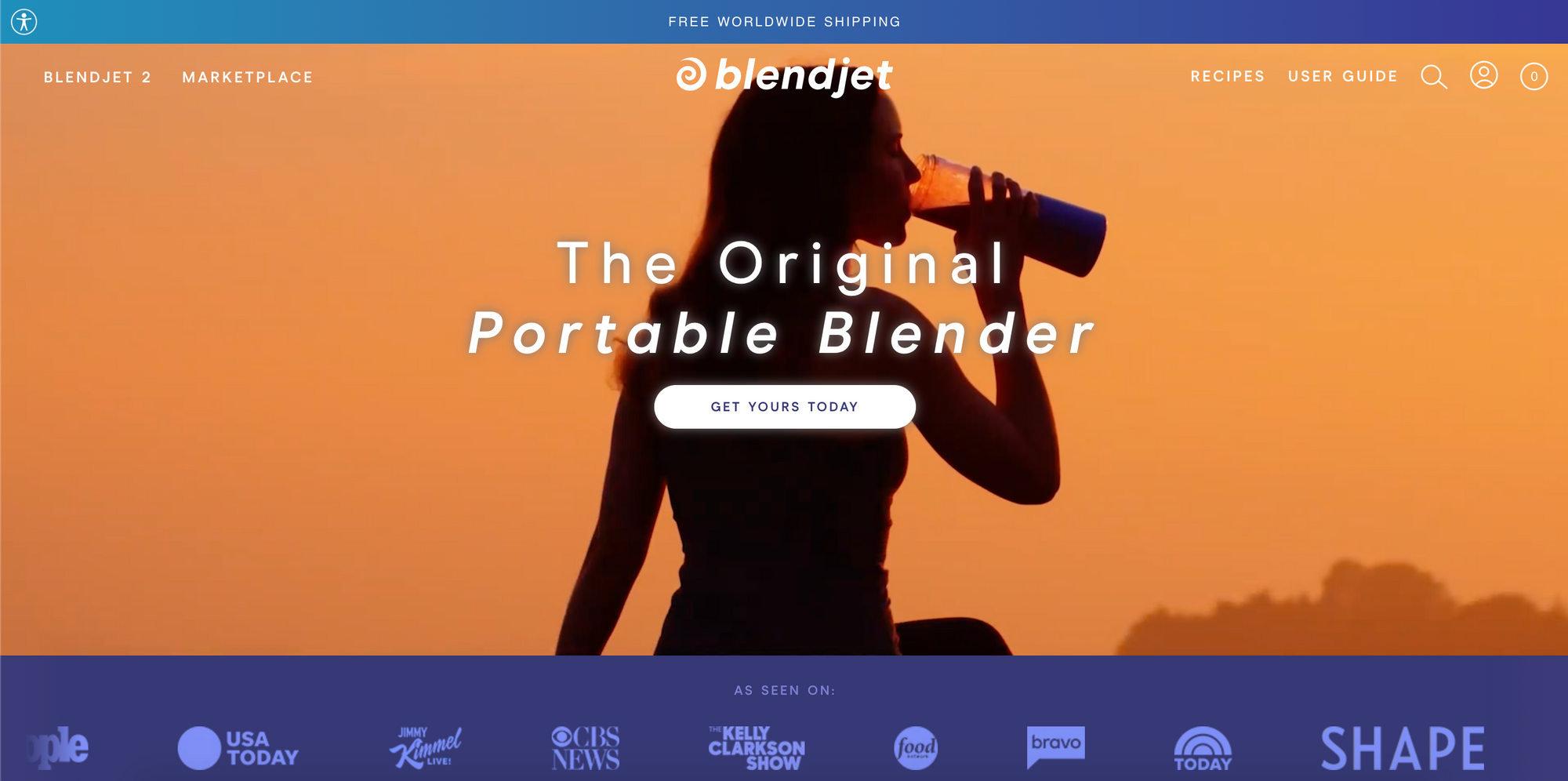
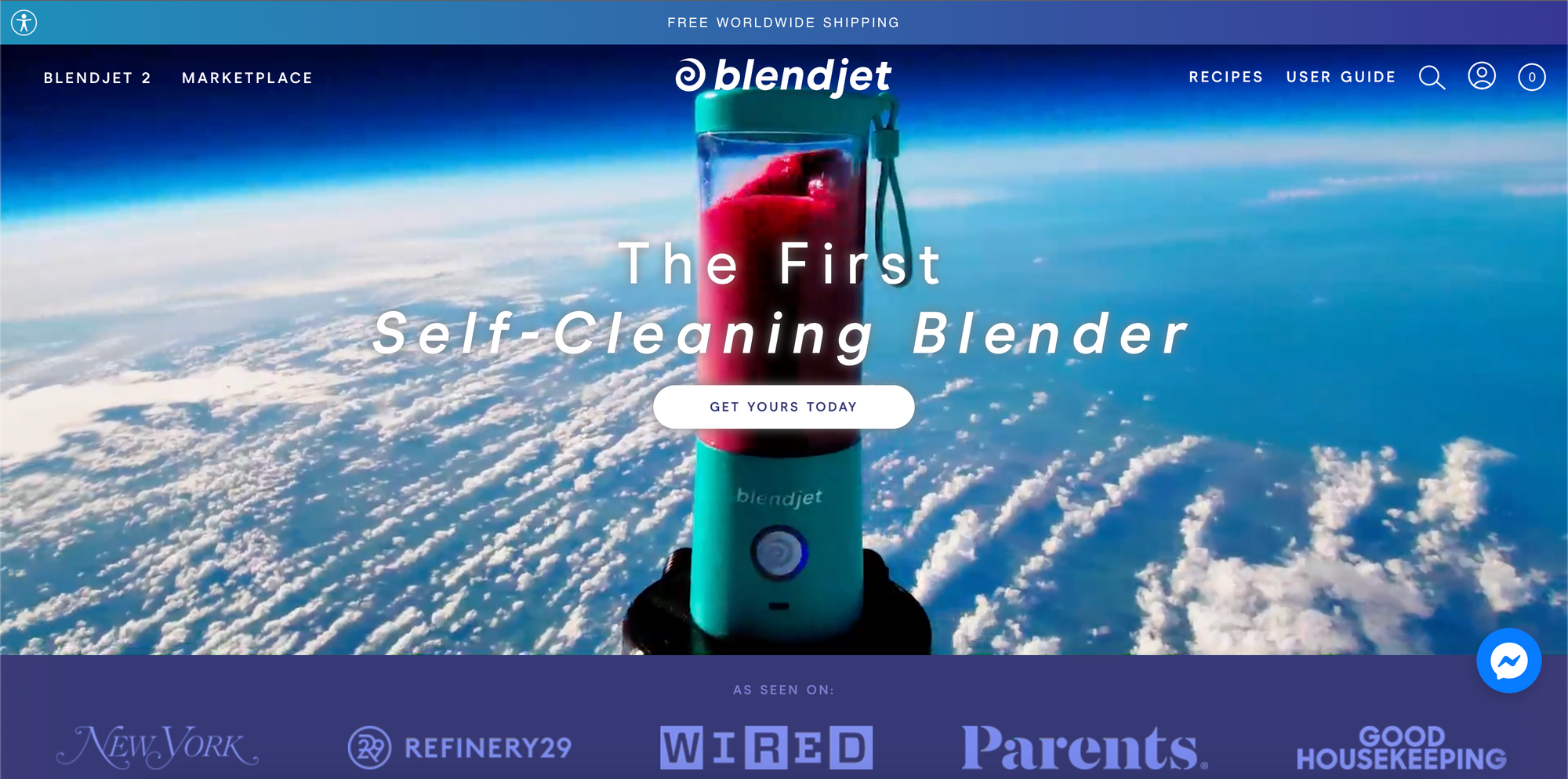
Here’s another example from Obvi. They have two unique selling propositions: one for visitors who would like to lose weight…
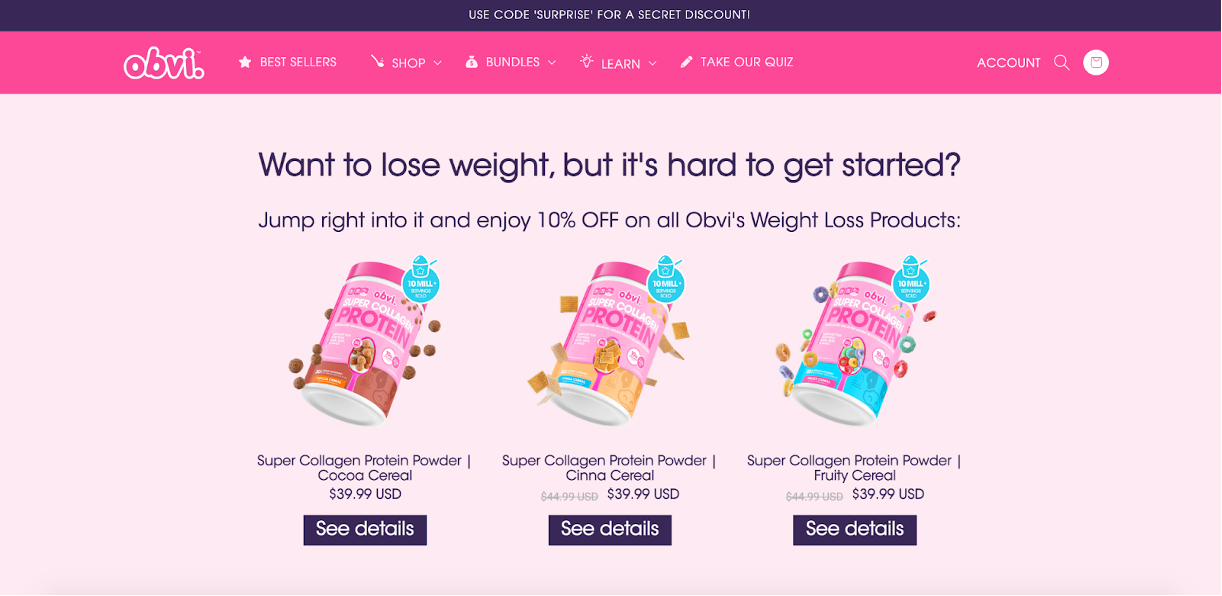
And another for those who want to sleep better:
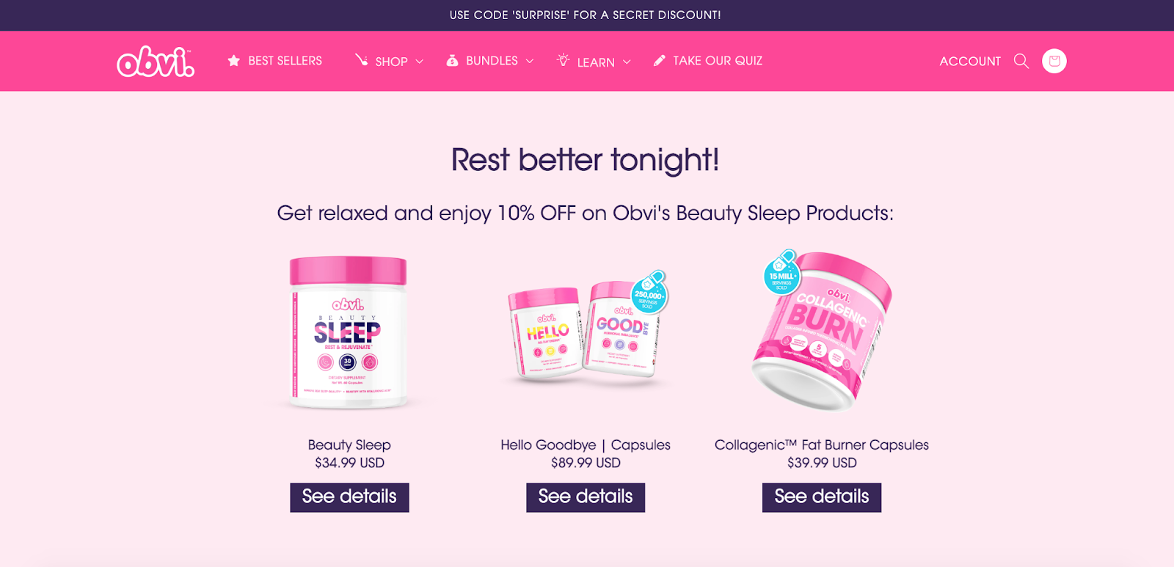
Once you’ve identified your USP, make sure to communicate it clearly and consistently.
How to promote your USP
Once you’ve put in all the work to create a great unique selling point for your company, you need to integrate it into your marketing strategy. Make sure people see it and associate it with your brand!
To achieve that, you should highlight your USP everywhere: not just on the homepage of your online store, but also in your ad copy and on your marketing messages, including your popups.
What is a Unique Selling Proposition? With 15 USP Examples (2023)
Every business does something unique that sets them apart from the competition. You might offer a higher-quality product, provide exceptional customer service, or fulfill orders faster than anyone else. But it doesn’t give you an advantage if no one knows about it!
That’s where your USP comes in. As a business owner, you need to sum up your company’s unique strengths in a simple sentence that everyone can understand.
In this post, we’ll go over what exactly a unique selling proposition is, and we’ll examine 15 strong USP examples and tips that will inspire you to create your own.
What is a unique selling proposition?
A unique selling proposition is a unique aspect of a company’s products and/or services that sets them apart from what competitors offer.
It’s often summed up in one statement (ten words or less) that’s concise, catchy, and memorable.
To understand the difference from slogan, let’s look at the company slogan: “Taking your business to the next level.” It sounds great, but it’s not a USP. It doesn’t help prospective customers understand exactly why they should choose you over other brands. Customers will have lingering questions like, “How are they going to take my business to the next level?” or “Is this company going to help me finance my business upgrades?” This confusion can cause you to lose business.
Compare that to Sirius XM’s compelling USP: “180+ channels, commercial-free music.”
Those few words explain exactly what’s unique about their satellite radio in comparison to regular radio. Namely, you’ll have more choices, and you won’t need to listen to ads.
To sum up, the best answer to the question “What is a USP in marketing?” is that it’s a sentence that expresses the qualities that differentiate your company from other businesses.
Now it’s time for our deep dive into some unique selling propositions.
15 strong unique selling proposition examples and why they work

Let’s take a look at some effective unique selling proposition examples.
1. Bee’s Wrap: “A Simple Solution to Plastic Pollution”
Bee’s Wrap sells reusable food wraps that are made from cotton, beeswax, and tree resin to replace plastic wraps.
The name of the company, “Bee’s Wrap,” already denotes natural, healthy products, and their USP reinforces the environmental benefits of using their wrap.
Thus, they’re able to position themselves as solving a problem that no one likes—plastic pollution—differentiating themselves from their competition.
 2. FedEx: “When it absolutely, positively has to be there overnight”
2. FedEx: “When it absolutely, positively has to be there overnight”FedEx used this strong unique selling proposition between 1978 and 1983. And it’s been taught in business schools ever since.
The whole point of FedEx is getting packages from one place to another, quickly and reliably. They state this clearly in their USP.
The repetition “…absolutely, positively…” subtly draws attention to the fact that FedEx knows the importance of overnight shipping for their customers. And they promise to deliver.
3. Hiut Denim Co.: “Do one thing well”
It’s tough to create a USP if you’re a denim manufacturer, because your competitors’ products likely look very similar to yours.
Hiut Denim Co. used an interesting tactic to concoct a winning USP: they simply boasted that they make jeans…nothing else. This statement sews the idea that if a company is devoted to just one task, they can master it.
Furthermore, it implies (without saying so explicitly) that any company that makes both jeans and other types of products isn’t fully committed to making denim clothing. In the consumer’s mind, this translates to a lesser-quality product.

4. Bellroy: “Slim your wallet without turning your world upside down”
Bellroy’s USP plays on the importance of wallets in our everyday life.
They offer slimmer, less obtrusive wallets that won’t make you feel like you’re losing anything by switching over to their product.
This value proposition is clever because it not only highlights their most important differentiating factor (how slim their wallets are), but also addresses common customer worries, like “can I fit everything?” or “isn’t changing to a new wallet too much trouble?”
And they do it all in a single sentence. Pretty impressive!
It’s tough to create a USP if you’re a denim manufacturer, because your competitors’ products likely look very similar to yours.
Hiut Denim Co. used an interesting tactic to concoct a winning USP: they simply boasted that they make jeans…nothing else. This statement sews the idea that if a company is devoted to just one task, they can master it.
Furthermore, it implies (without saying so explicitly) that any company that makes both jeans and other types of products isn’t fully committed to making denim clothing. In the consumer’s mind, this translates to a lesser-quality product.

4. Bellroy: “Slim your wallet without turning your world upside down”
Bellroy’s USP plays on the importance of wallets in our everyday life.
They offer slimmer, less obtrusive wallets that won’t make you feel like you’re losing anything by switching over to their product.
This value proposition is clever because it not only highlights their most important differentiating factor (how slim their wallets are), but also addresses common customer worries, like “can I fit everything?” or “isn’t changing to a new wallet too much trouble?”
And they do it all in a single sentence. Pretty impressive!

5. American Musical Supply: “Rock now! Pay later.”
This is one of the best examples of how a USP can reflect a company’s brand and culture.
American Musical Supply is an online retailer of musical equipment. And they know that their customers want to buy expensive items without breaking the bank (especially people starting a new musical hobby, beginners in school, or shoppers on a tight budget).
When their customers realize they can use a payment plan, they start to shop more freely without limiting themselves to a certain price point.
This USP speaks to what matters most to American Musical Supply’s customers—getting the right gear, right now.

6. WooCommerce: “The most customizable eCommerce platform for building your online business”
The company’s USP works for two reasons. First of all, the superlative (“the most customizable”) instantly raises it above the competition.
But perhaps more importantly, it also speaks to an aspect of website building that potential customers worry about: whether their site will look too formulaic or “cookie-cutter.”
WooCommerce successfully builds their USP around an aspect of their service that people care about.

7. Domino’s Pizza: “Fresh hot pizza, delivered in 30 minutes or less or it’s FREE!”
Domino’s Pizza has a memorable USPs that consumers associate with the brand: “Fresh hot pizza, delivered in 30 minutes or less or it’s FREE!” or "50% Off Pizza when you spend 30 or more online".
Their specific promise allows customers to form concrete expectations about their service. It’s also not something you’re used to hearing from delivery services, which makes it stand out.
or "100% GUARANTEE a SUCCESSFUL FUTURE by 8 Unique Courses or it’s FREE!”
or "We GUARANTEE a Full Potential Unleashing of Your Child by 8 Unique Courses!"
MiniBoss sells world-class business education courses for kids and teens aged 6-17 that are made by famous entrepreneurs Olga and Andrii Azarov, and consist of 8 courses and 12 types of practice.
The name of the company, “MiniBoss” already denotes business founder level of personality, it means personality have to be under high development much higher than a level of regular comprehensive schools, and their USP reinforces the entrepreneurial benefits as a key result of education. Thus, they’re able to position themselves as solving a problem of poverty — differentiating themselves from other schools.
Their specific promise, which they frame as a guarantee, allows customers to form concrete expectations about their service. Finally, the rhyme in their USP (“guarantee” and “free”) helps a customer remember it.
.jpg)
9. Pureformulas: “Orders placed before 6 pm EST ship the same day”
Pureformulas’ unique selling proposition is tailor-made for people who care about their vitamins and supplements. They know that their customers don’t want to miss taking them, even for a single day.
That’s why their USP, with its promise of same-day shipping, perfectly meets their customers’ needs and differentiates them from their competitors.

10. Best Buy: “Find a lower price and we’ll match it”
Best Buy’s famous USP helped define them as a brand. Since consumers usually can’t get a lower price than the sticker price—especially in electronics stores—Best Buy’s USP promises something unique: an unfettered ability to price match.
Interestingly, the subtext of the USP adds another layer: it’s almost like a challenge. Best Buy implies that you won’t be able to find lower prices, because theirs are the best.

11. Warby Parker: “Try 5 frames at home for free”
Warby Parker’s clever USP solves the biggest problem with buying glasses in an online store: it’s very hard to imagine what you’d look like in a pair of glasses without actually trying them on!
That’s why their offer to try on five different frames for free is so effective. They’re eliminating the risk involved with choosing a pair of frames online—if the customer isn’t thrilled with the first pair, it’s no big deal… they’ve also got four other options.

12. GEICO: “15 minutes could save you 15% or more on car insurance”
Just like FedEx, GEICO uses repetition in its USP to make it more memorable: 15 minutes and 15 percent.
This highlights the benefit new customers can expect by switching to GEICO from their current insurance providers. When you combine their USP with GEICO’s other memorable marketing efforts, you can see why they became such a successful business.

13. M&M’s: “Melt in your mouth, not in your hand”
M&M’s USP shows that being slightly offbeat in your selling proposition can yield great results.
When you read it, you might be puzzled at first, but then you remember that M&M’s have that hard shell that protects your hands. At the same time, you might imagine melted chocolate all over your hands from eating other types of candy.
At this point, you can almost taste the chocolate melting in your mouth…
By the time you’re done thinking, M&M’s USP has already worked!

14. Colgate – “Improve mouth health in two weeks”
Colgate’s USP highlights the role of toothpaste for mouth health. They know that their target audience wants an established, reputable brand when it comes to health.
And by making a specific, time-limited promise, “improve mouth health in two weeks,” Colgate projects confidence that they can actually deliver those results.

15. Patch: “Patch helps you discover the best plants for your space, delivers them to your door and helps you look after them”
Patch’s unique selling proposition is a little bit long, but it works because they need to establish what they do for their customers. The company doesn’t have the history and name recognition of FedEx or M&M’s, so they need to be more specific in their USP.
They offer three services: discovery, delivery, and post-delivery assistance.
Notice how their USP complements their slogan: Plants made easy.

4 steps for determining your ideal unique selling point
We’ve gone over some great examples of unique selling propositions. Now, let’s take a look at the steps you need to follow to create your own USP.
1. List your key differences
The first step in coming up with a unique selling proposition is to find aspects of your products or services that your competitors can’t provide or don’t have.
For example, if you’re the only one in your niche market offering free shipping, that could be a part of your USP. Or your products might be more customizable than what other businesses are offering.
Once you have an exhaustive list of what differentiates your company from the rest of your industry, you’ll have tons of options for your USP. But that’s not the end of the process.
2. Research your competition
You also need to research your competition and look at their USPs.
This is another point where making a list is helpful. When you write out the USPs of other businesses in the same category, you’ll be able to see gaps in the market and use them to differentiate your brand.
For instance, if your competitors are focusing on their shipping policies, you could focus on something else.
3. Think about your customers’ needs
Now, it’s time to research your customers’ needs and expectations.
Another idea is to conduct focus groups with your ideal customer.
Once you learn what your customers value, you’ll be able to see and solve any pain points that your competitors haven’t even considered.
4. Put it all together
These three steps we’ve just discussed should come together in your unique selling proposition.
The ideal USP should include: Something unique about your company
Something that’s missing from your competitors’ USPs
Something important to your customers
How to find your USP?
Finding your unique selling proposition is not always easy, and you probably have a few competing ideas. Not sure which will work best?
We suggest running an A/B test to find out which USP resonates most with your visitors and potential customers.
For example, BlendJet uses two different headlines to promote their product: “The Original Portable Blender” vs “The First Self-Cleaning Blender”.


Here’s another example from Obvi. They have two unique selling propositions: one for visitors who would like to lose weight…

And another for those who want to sleep better:

Once you’ve identified your USP, make sure to communicate it clearly and consistently.
How to promote your USP
Once you’ve put in all the work to create a great unique selling point for your company, you need to integrate it into your marketing strategy. Make sure people see it and associate it with your brand!
To achieve that, you should highlight your USP everywhere: not just on the homepage of your online store, but also in your ad copy and on your marketing messages, including your popups.
For example, you can use a sticky bar to promote your USP. It displays your message without disrupting your visitors’ browsing experience.
Summing up
Understanding your unique selling proposition and effectively communicating it to your customers can lead to rapid business growth. It’s all about letting your target audience know what’s special about your products or services.
Did we miss any useful tips to create an effective USP? Let us know in the comments!
Updated by Optimonk & MiniBoss Global
Summing up
Understanding your unique selling proposition and effectively communicating it to your customers can lead to rapid business growth. It’s all about letting your target audience know what’s special about your products or services.
Did we miss any useful tips to create an effective USP? Let us know in the comments!
